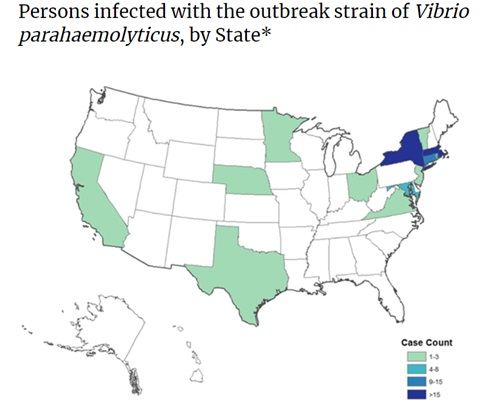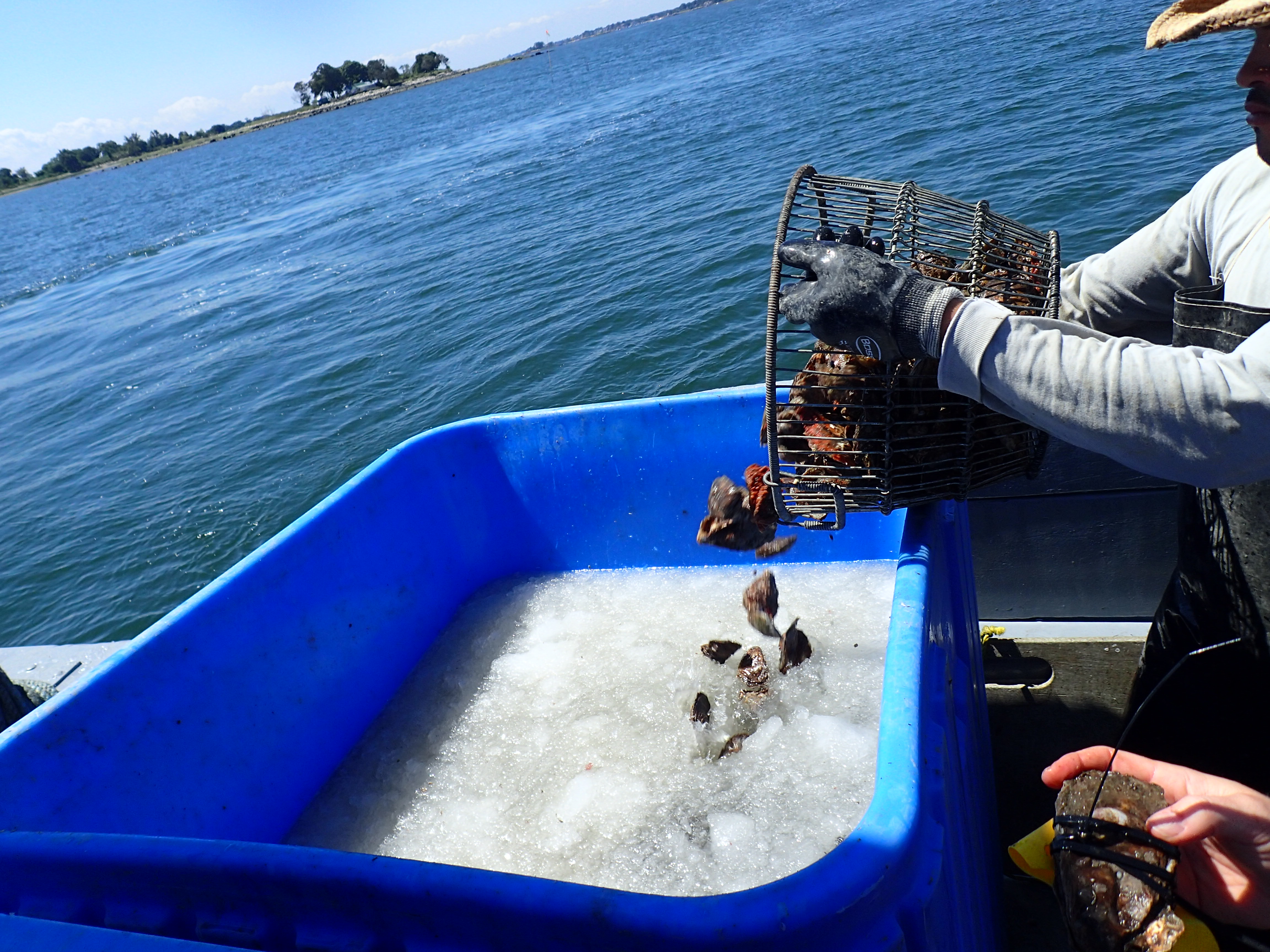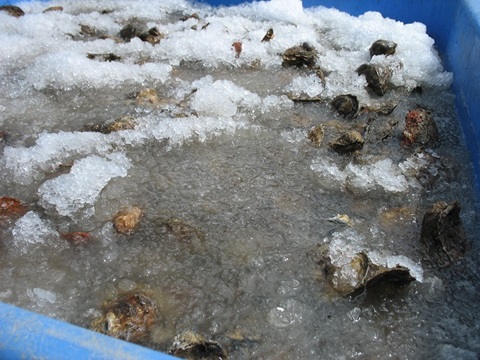Vibrio information and management in Connecticut shellfish
What are Vibrio?Vibrio bacteria naturally occur in coastal waters and are more abundant during the summer as the water warms. Vibrio species can cause a wide range of infections in humans, including Vibriosis, which is the leading cause of seafood-associated morbidity and mortality in the U.S. Vibrio parahaemolyticus is the leading cause of seafood-associated gastroenteritis in the U.S and world. Other important Vibrio species include Vibrio vulnificus, which can cause severe wound and blood infections, and Vibrio cholerae, of which nontoxigenic strains can cause gastroenteritis and toxigenic strains can cause cholera. Molluscan shellfish are highly efficient filter feeders and can concentrate Vibrio when present in the water column, which can potentially sicken consumers that eat raw or undercooked seafood. National shellfish sanitation programs monitor Vibrio concentrations in shellfish; implement control plans to reduce the risk of Vibrio illnesses; and conduct traceback illness investigations when Vibrio illnesses are reported to identify implicated states and shellfish growing areas, promptly close harvesting in these growing areas, and recall and destroy contaminated shellfish harvested from these growing areas to prevent further illnesses.
2013 Vibrio parahaemolyticus outbreak in New England
Prior to 2012, Vibrio parahaemolyticus infections from shellfish consumption was rare in Connecticut. In 2012, pathogenic Vibrio parahaemolyticus strains originating on the U.S. Pacific Coast were detected in New England waters and correlated to higher Vibrio parahaemolyticus infections (Martinez-Urtaza et al. 2013). Connecticut precautionarily closed growing areas in 2012 to prevent Vibrio parahaemolyticus illnesses and implemented control plans that limited time from harvest to refrigeration to 5 hours and required oysters to be cooled to <50°F within 5 hours of refrigeration. In 2013, 104 cases of a specific Pacific coast Vibrio parahaemolyticus strain were associated with an unprecedented outbreak across 13 states, including 7 New England states (CDC 2013). Connecticut shellfish growing waters in Westport, Norwalk, and Darien were the implicated in 23 confirmed Vibrio parahaemolyticus illnesses in 2013. Since 2013, the Bureau of Aquaculture developed extremely effective rapid-cooling procedures and adapted control plans to significantly reduce Vibrio parahaemolyticus illnesses associated with Connecticut shellfish. Connecticut harvesters have not been implicated in an outbreak since 2013.

CDC 2013 Vibrio parahaemolyticus Outbreak Map (all rights reserved)
Vibrio control plans in Connecticut have effectively reduced Vibrio illnesses since implementation in 2014
Connecticut shellfish growing areas are annually managed with Vibrio parahaemolyticus Control Plans when water temperatures exceed 68°F, due to the 2013 outbreak.
- In areas implicated in the Vibrio parahaemolyticus outbreak in 2013, all harvested oysters are immediately placed in an ice slurry, which drops the internal temperature to <50°F within 3 hours of harvest.
- In areas not implicated in the V. parahaemolyticus outbreak in 2013, all harvested oysters must be refrigerated, or placed on ice, within 5 hours of harvest. Under this control plan, the internal temperature of oysters must be <50°F within 5 hours of refrigeration/icing. However, most harvesters choose to rapidly cool oysters statewide.
- All harvesters are required to shade oysters while on the vessels to further prevent temperature abuse.
Since the implementation of these controls, CT has not experienced an outbreak of Vibrio parahaemolyticus.


Adding oysters to ice slurry (top) and oysters in the ice slurry (bottom).
Connecticut shellfish have never been associated with a Vibrio vulnificus outbreak. Vibrio vulnificus does cause wound infections in CT.
Vibrio vulnificus can cause infections from consumption of raw or undercooked seafood; however, no Connecticut shellfish have ever been associated with Vibrio vulnificus illnesses. Nationally, there are approximately 150-200 Vibrio vulnificus infections reported to the CDC each year, of which only 10% are associated with shellfish consumption (CDC, 2023). The remaining 90% of cases are caused by open-wound contact with salt or brackish water (CDC, 2023).
Vibrio vulnificus naturally occurs in Long Island Sound, and can cause wound infections that can lead to limb amputation and sepsis in severe cases. In 2020, there were 5 confirmed Vibrio vulnificus wound infections, while there were only 7 total cases from 2010-2019 (Connecticut Department of Public Health). To minimize the risk of Vibrio vulnificus wound infections, the Department of Public Health recommends staying out of salt and brackish water when wounds are present, or cover wounds with a waterproof bandage if avoidance is not possible. Protective gloves can be worn when crabbing, fishing, and shellfishing. If a wound is sustained, wash the area thoroughly with soap and water. The Bureau of Aquaculture has prepared a Guidance Document for Recreational Shellfish Harvesting and Vibrio, and maintains a webpage on shellfish safety and handling.
In 2023, there were 2 Vibrio vulnificus wound infections in Connecticut, and 3 Vibrio vulnificus deaths in CT and NY in 2023. No Vibrio vulnificus illnesses have been reported from Connecticut shellfish, and the Bureau of Aquaculture routinely monitors for Vibrio vulnificus and Vibrio parahaemolyticus levels in commercial oysters statewide. The Bureau of Aquaculture did not detect Vibrio vulnificus in commercial oysters in 2022 or 2023. In 2023, one Connecticut resident contracted Vibrio vulnificus from consuming shellfish from outside of Long Island Sound (i.e. not CT or NY shellfish); however, as previously demonstrated, Vibrio vulnificus cases from shellfish consumption are very rare (only 15-20/year).

Confirmed Vibrio parahaemolyticus shellfish consumption cases (Bureau of Aquaculture) and confirmed Vibrio vulnificus wound cases (Department of Public Health) in Connecticut from 2009-2023. In 2023, there was one case of a Connecticut resident that contracted Vibrio vulnificus from consuming shellfish from outside of Long Island Sound. No Long Island Sound (CT and NY) shellfish have been implicated in a Vibrio vulnificus illness.
To learn more about Vibrio, visit the Bureau of Aquaculture's Vibrio frequently asked questions webpage.
References
-Centers for Disease Control and Prevention (CDC). Vibrio parahaemolyticus illnesses associated with consumption of shellfish, United States, 2013. Page last reviewed: October 21, 2013. Vibrio parahaemolyticus illnesses associated with consumption of shellfish, United States, 2013 | Investigation - Increase in Vibrio parahaemolyticus illnesses | Vibrio Illness (Vibriosis) | CDC
-CDC. Severe Vibrio vulnificus Infections in the United States Associated with Warming Coastal Waters. CDC Health Advisory. September 1, 2023. https://emergency.cdc.gov/han/2023/pdf/CDC_HAN_497.pdf
-Martinez-Urtaza J., Baker-Austin C., Jones J.L., Newton A.E., DePaola A. 2013. Spread of Pacific Northwest Vibrio parahaemolyticus Strain. The New England Journal of Medicine. 369: 1573-1574. DOI: 10.1056/NEJMc1305535. Spread of Pacific Northwest Vibrio parahaemolyticus Strain | NEJM

